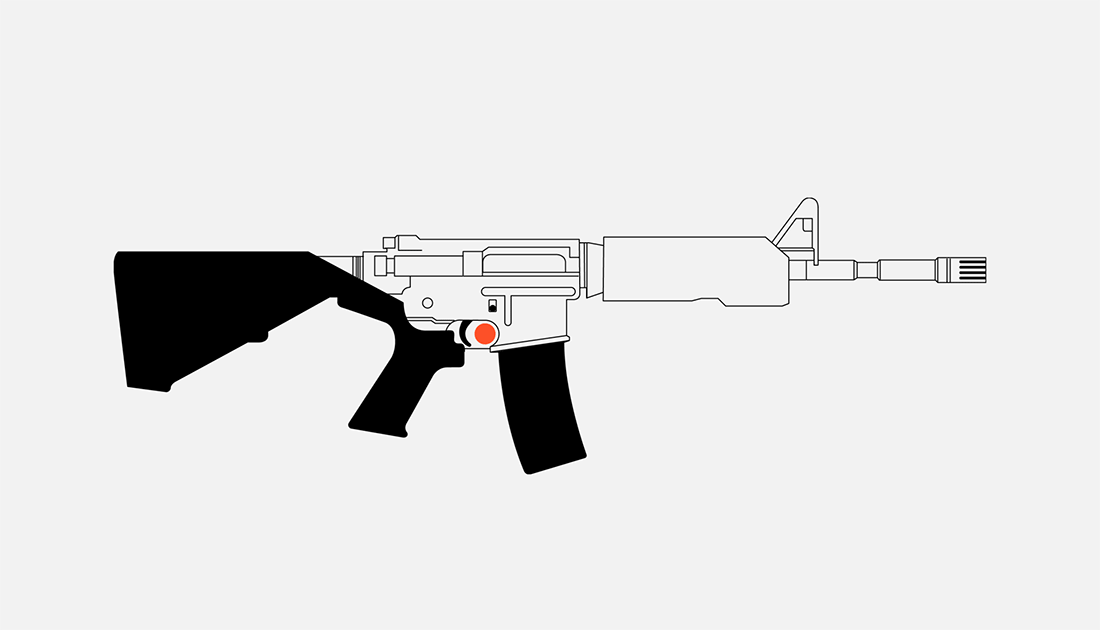Three days after Sunday’s mass shooting in Las Vegas, there is increasing certainty about which weapons the gunman, Stephen Paddock, used to kill nearly 60 people and wound hundreds more. On Tuesday night, the Associated Press, citing authorities at the Bureau of Alcohol, Tobacco, Firearms and Explosives, reported that of the 23 guns Paddock had in his room at the Mandalay Bay hotel, 12 were outfitted with “bump stock” devices — inexpensive gun accessories that enable semiautomatic firearms to mimic automatic gunfire.
Machine guns, defined as weapons that can fire more than one round with the single pull of a trigger, are legal to own in most of the United States. But strict regulations limit their availability and have driven their prices up to exorbitant levels. Bump stocks are part of a class of legal products that are designed specifically to increase a semiautomatic weapon’s rate of fire. When a bump stock or a comparable device is used correctly, the output of an average firearm is almost indistinguishable from that of a machine gun.
These accessories are not subject to federal regulations and are legal in all but a handful of states. They’re also cheap — a typical bump stock sells for a few hundred dollars online.
Below is a primer on how bump stocks and similar devices function, and why they’re legal.
Bump Stock
To fire a standard semiautomatic gun, the user squeezes the trigger each time he wants to discharge a round. When employing a bump stock, however, the shooter keeps his trigger finger rigid. Using his second hand, he gently pushes the gun forward. The forward movement causes the user’s finger to depress the trigger. The shot’s recoil then drives the gun backward, and the bump stock is designed to allow this cycle of discharge and recoil until the shooter chooses to stop firing or the gun’s magazine is spent.
Until this week, bump stocks were little known outside the gun world and existed mostly as a novelty item. They can be purchased online through multiple retailers, for between a $100 and $200. (In the wake of Sunday’s shooting, Walmart and Cabela’s, two major firearms retailers, appear to have pulled bump stocks from their shelves.)
Rotating-Trigger Actuator
A rotating-trigger actuator is affixed to a gun’s trigger guard. Rotating the device’s crank turns a gear whose teeth depress the trigger — allowing a user to discharge several shots per revolution.
Rotating-trigger actuators mimic the functionality of a Gatling gun, the Civil War-era machine gun. A product called a GatCrank is available online for $40 dollars.
Hellfire Trigger
A hellfire trigger is a spring-loaded pedal placed behind a gun’s trigger. When the trigger is pulled, the spring quickly pushes it back to firing position, enabling rapid fire.
Hellfire triggers gained notoriety in 1993, when a gunman used a weapon equipped with one to kill eight people and injure six more at a law office in San Francisco. Hell-Fire Systems Inc., the maker of the original device, went bankrupt in 1994. New iterations of the hellfire trigger, however, are available online, for as little as $59.95.
In a few states, lawmakers have taken action to crack down on these devices. According to the Law Center to Prevent Gun Violence, California bars the ownership of “multiburst trigger activators,” a definition that includes bump stocks, and devices like the GatCrank and the Hellfire Trigger. Connecticut, Iowa, and Minnesota have similar restrictions in place.
Senator Dianne Feinstein of California, who authored the now expired 1994 ban on assault weapons, has pushed for nationwide legislation banning the sale of bump stocks and related devices. In 2013, in the wake of the mass shooting at Sandy Hook Elementary School, in Newtown, Connecticut, which claimed the lives of 20 schoolchildren and six adults, Feinstein proposed a prohibition on the accessories. Congress rejected it. On Wednesday afternoon, Feinstein again reintroduced a bill that would outlaw bump stocks and accessories designed to mimic a machine gun’s rate of fire.




